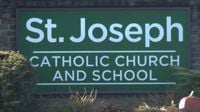On the evening of October 30, 2025, the small town of Hanover, Pennsylvania, found itself at the center of a national controversy after a Halloween parade float from Saint Joseph Catholic School replicated the infamous Auschwitz concentration camp gate, complete with the chilling phrase, "Arbeit Macht Frei"—"Work Makes You Free." The float, displayed during a local parade in the Diocese of Harrisburg, immediately drew outrage from spectators who recognized the symbol and quickly spread their anger both online and throughout the community.
The gate, a marker of unimaginable suffering and genocide during the Holocaust, was mounted on a trailer and processed through Hanover’s central square, surrounded by the trappings of a typical Halloween celebration: pumpkins, ghosts, and children and adults dressed in green, as Little Richard’s "Tutti Frutti" played in the background. Yet, the float’s back bore the unmistakable sign that once greeted prisoners at the Nazi death camp—a sight that, for many, transformed a festive event into a moment of horror and grief.
Reactions were swift and severe. Bishop Timothy C. Senior, whose diocese includes Saint Joseph Catholic School, issued a statement on November 4, 2025, expressing his deep dismay. According to the Associated Press, Bishop Senior declared, "The inclusion of this image—one that represents the horrific suffering and murder of millions of innocent people, including six million Jews during the Holocaust—is profoundly offensive and unacceptable." He emphasized that the original, approved design for the float did not feature the Auschwitz gate, but that did little to mitigate the pain caused by its appearance. "As Catholics, we stand firmly against all forms of antisemitism, hatred, and prejudice, which are rampant in our society," he stated, adding, "I express my sincere apology to our Jewish brothers and sisters and to all who were hurt or offended by this display."
The Jewish Federation of Greater Harrisburg also condemned the float, stating that the depiction of the Auschwitz gate is never acceptable outside an educational context. Their response highlighted the deep wounds such imagery can reopen, even decades after the Holocaust. The Federation called for the institutions involved to partner on opportunities that would "bring better understanding to the history of these symbols and images and help ensure that ‘Never Again’ is a reality."
Galen S. Shelly, the float’s designer, identified himself online and in interviews, expressing regret and attempting to explain his intent. As reported by Pennlive, Shelly said he had planned to use a lighted archway as part of the float, but when it failed to arrive on time, he constructed his own gate. "I wanted to illustrate the idea none of us get out of this life alive," he told the news organization. Shelly maintained that he had "no ill intent," and that a church trip to the U.S. Holocaust Memorial Museum in Washington, D.C., had "deeply moved" him. He claimed his aim was to convey a message about memory and repentance, and that the phrase "Arbeit Macht Frei" was meant as a metaphor for the false belief that "works" alone can save people. Nevertheless, he admitted, "I made a mistake and I am deeply sorry."
Metcalf Family Cleaning, the company that volunteered to tow the float during the parade, also issued an apology, clarifying that they had no role in designing the decorations or messaging. "Regrettably, the float contained a phrase in German that was later found to be derogatory," the company said in a statement. "At the time, we were unaware of its meaning and significance. We recognize that we should have taken a closer look at the float prior to the parade, and we are truly sorry for that oversight."
For many in Hanover and beyond, the incident underscored a deeper issue: a lack of cultural literacy and awareness about the Holocaust and its enduring symbols. Matthew Jackson, a local advocate for equality and social justice, told the Associated Press, "I think a lot of people didn’t know what it meant. But that doesn’t take away the harm of it." He added, "The community needs to do a much better job of interracial and interfaith dialogue."
The parade incident did not just spark outrage; it also led to real-world consequences. On November 2, 2025, Joseph Gilleo II, a 28-year-old from Bucks County, was charged with terroristic threats and other offenses after leaving a threatening voicemail for St. Joseph Catholic School. According to ABC 27 News, Gilleo’s message included statements like, "Maybe we should turn your little school into a concentration camp. Maybe it’s time to persecute you. Your children are now in danger." The parish responded by canceling events scheduled for the weekend of November 2-3, and future gatherings were expected to be canceled as a precaution. Gilleo now faces a felony charge of terroristic threats, as well as misdemeanor charges of ethnic intimidation, disorderly conduct, and harassment.
The float’s display and its aftermath have drawn attention to the ongoing challenges in addressing antisemitism and Holocaust education. The misuse of Holocaust symbols, whether through ignorance or misguided intent, trivializes the suffering of millions and distorts the historical record. As one analysis in the Christian Post pointed out, reproducing the Auschwitz gate as a parade decoration "does not educate; it desecrates memory and inflicts deep pain on survivors and their descendants."
Such incidents reveal the importance of clear standards for recognizing and combating antisemitism. The International Holocaust Remembrance Alliance (IHRA) Working Definition of Antisemitism offers a framework for understanding how classic antisemitic symbols—even when not accompanied by explicit hate speech—can perpetuate harmful ideas and normalize insensitivity toward Jewish trauma. The definition describes antisemitism as "a certain perception of Jews, which may be expressed as hatred toward Jews," and it includes examples that address the misuse of Holocaust imagery.
In response to the controversy, Bishop Senior committed to working with the school community to ensure that the incident becomes "an opportunity for education and reflection," and to review approval processes so that "such a grievous incident is never repeated." The hope, echoed by both Catholic and Jewish leaders, is that through honest dialogue, education, and a renewed commitment to remembrance, the community can move forward—and that the lessons of the Holocaust will not be lost to ignorance or indifference.
For Hanover, the parade float was a painful reminder that history’s darkest symbols still hold power—and that vigilance, understanding, and compassion are as necessary now as ever.






